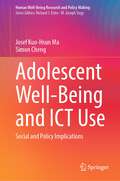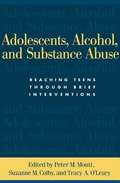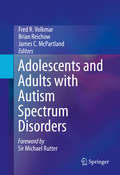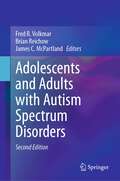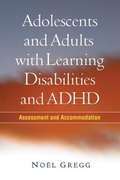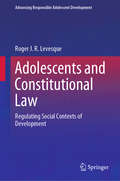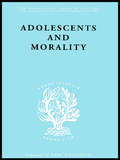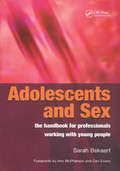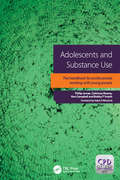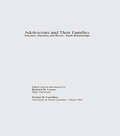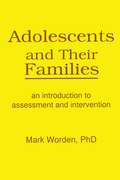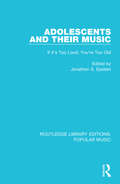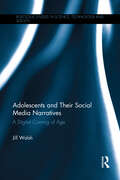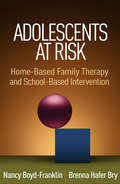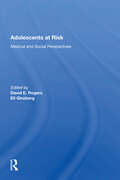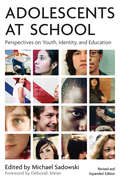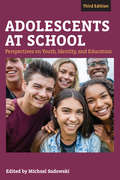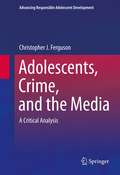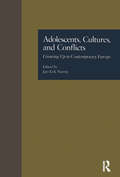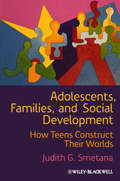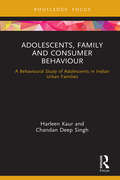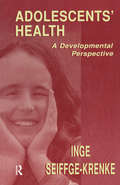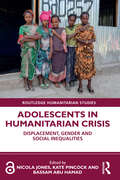- Table View
- List View
Adolescent Well-Being and ICT Use: Social and Policy Implications (Human Well-Being Research and Policy Making)
by Simon Cheng Josef Kuo-Hsun MaIn this book, the authors expertly examine the issue of adolescent well-being in the light of their exposure to and use of information and communication technologies (ICTs) at school and home. The authors discuss a new form of inequality especially noticeable among youth, which is, digital inequality/divide, created through rapid developments in ICT. They analyze the relation between digital divide and educational inequality among youth, describe patterns of social exclusion from technology and education, and discuss related policies in industrialized nations to see how well-being issues can be addressed in this context. Comparing results based on nationally representative and internationally comparative datasets across 28 countries, the authors ask how and why the benefits accruing from ICT are substantially greater for some adolescents, but apparently smaller for others and how such differences may be reduced. They provide policy suggestions that are broadly based in the fields of well-being, secondary education, and technology use. This book is of interest to researchers and students of quality of life and well-being studies and a wide range of social science and education disciplines, including the sociology of education, media sociology, sociology of childhood and adolescence, communication studies, and science and technology education.
Adolescents, Alcohol, and Substance Abuse
by Peter MontiHow do substance abuse and dependence in adolescents differ from related problems in adults? Can treatment principles that work with adults be adapted successfully to meet the special needs of teens? This volume reviews a range of empirically supported approaches to dealing with alcohol and other drug problems in this large and diverse clinical population. The focus is on motivationally based brief interventions that can be delivered in a variety of contexts, that address key developmental considerations, and that draw on the latest knowledge about the processes of addictive behavior change. Bringing together a multidisciplinary group of expert contributors, this is an essential resource for anyone working with or studying adolescents at risk. Part I reviews current research on substance abuse in adolescents and young adults and outlines the basic principles of developmentally informed assessment and intervention. Contributors point out that admission to specialized treatment programs is relatively rare in today's health care climate, but there exist many opportunities for prevention, skills training, and harm reduction efforts. Emphasized are the benefits of working with young people on their "home turf" and reaching out to all individuals engaging in health-risk behavior, not just those seeking intensive treatment. Part II presents a range of specific interventions, including alcohol skills training; integrative behavioral and family therapy; motivational interviewing; interventions for dually diagnosed youth; Internet-based education, prevention, and treatment; and applications to HIV prevention. Chapters describe the goals and methods of these approaches, review available data on their efficacy, and offer case illustrations and clinical pointers. The volume concludes by outlining a broad agenda for future transdisciplinary investigation. Forging new connections among theory, research, and practice, this book belongs on the desks of all mental health practitioners and social service providers working with adolescents, as well as researchers and students in psychology, psychiatry, social work, and public health. It serves as a timely and relevant text for graduate-level courses. This volume reviews a range of empirically supported approaches to dealing with the growing problems of substance use and abuse among young people. While admission to specialized treatment programs is relatively rare in today's health care climate, there are many opportunities for brief interventions. Brief interventions also allow the clinician to work with the teen on his or her "home turf," emphasize autonomy and personal responsibility, and can be used across the full range of teens who are engaging in health-risk behavior. Bringing together a multidisciplinary group of experts, the volume reviews general principles of harm reduction and the stages of change, discusses developmental considerations, and outlines key components of assessment and intervention. Chapters then describe specific applications that can typically be implemented in one to five sessions, including alcohol skills training, integrative behavioral and family therapy, motivational interviewing, interventions for dually diagnosed youth, and use of the Internet for education, prevention, and treatment. The volume is extensively referenced and includes numerous clinical illustrations and vignettes.
Adolescents and Adults with Autism Spectrum Disorders
by Fred R. Volkmar Brian Reichow James C. McpartlandThe research on children with autism spectrum disorders (ASD) is extensive and growing. Although these conditions are recognized as affecting the entire lifespan, the literature on ASD after childhood is limited and has not been brought together in a single volume in over a decade. Adolescents and Adults with Autism Spectrum Disorders fills this knowledge gap by focusing on needs and difficulties unique to these stages of development. Expert contributors offer cogent reviews of complex issues, from education to employment, leisure activities to illegal behaviors, mental health issues to medical health concerns. The latest findings in key areas, such as psychosocial and residential treatments, social skills programs, epidemiology, the impact of ASD on families, are examined in detail. Throughout the volume, coverage focuses on areas requiring improved models of assessment, updated data, new interventions and increased support services. Featured topics include: Transition from high school to adulthood for adolescents and young adults with ASD. Innovative programming to support college students with ASD. Romantic relationships, sexuality and ASD. Treatment of mental health comorbidities. Assessment and treatment planning in adults with ASD. The range of outcomes and challenges in middle and later life. Adolescents and Adults with Autism Spectrum Disorders is a must-have reference for a wide range of clinicians and practitioners - as well as researchers and graduate students - in clinical child, school and developmental psychology; child and adolescent psychiatry; social work; rehabilitation medicine/therapy; education and general practice/family medicine. It will also serve as an important resource for parents and caregivers with its focus on translating the current state of knowledge relevant to understanding adolescents and adults with ASD into practical and relevant recommendations on how best to support them.
Adolescents and Adults with Autism Spectrum Disorders
by Fred R. Volkmar Brian Reichow James C. McPartlandThe second edition of this book examines the numerous research and practice advances with regard to adolescents and adults with autism spectrum disorders (ASD). Expert contributors offer cogent reviews of complex issues, from education to employment, leisure activities to illegal behaviors, mental health issues to medical health concerns. The volume explores the latest findings in key areas, such as psychosocial and residential treatments, social skills programs, epidemiology, the impact of ASD on families. The book focuses on areas of research and practice that require improved models of assessment, current data, new interventions, and increased support services. Key areas of coverage include: Transition from high school to adulthood for adolescents and young adults with ASD. Innovative programming to support college students with ASD. Romantic relationships, sexuality and ASD. Treatment of mental health comorbidities. Assessment and treatment planning in adults with ASD. The range of outcomes and challenges in middle and later life for individuals with autism. The second edition of Adolescents and Adults with Autism Spectrum Disorders is a must-have reference for researchers, professors, and graduate students as well as clinicians, therapists, and other practitioners in clinical child, school, and developmental psychology, psychiatry, social work, rehabilitation medicine/therapy, special education, and general practice/family medicine.
Adolescents and Adults with Learning Disabilities and ADHD
by Noël GreggMost of the literature on learning disabilities and attention-deficit/hyperactivity disorder (ADHD) focuses on the needs of elementary school-age children, but older students with these conditions also require significant support. Comprehensive and authoritative, this book helps educators and clinicians navigate the maze of laws, policies, and scientific research relating to diagnostic and intervention decision making for adolescents and adults. Leading expert No\u00ebl Gregg provides clear guidance on how to conduct and document evidence-based assessments and select appropriate instructional and testing accommodations. Featuring helpful case vignettes, decision-making flowcharts, and coverage of the latest assistive technologies, the book gives special attention to supporting students during the crucial transition from high school to higher education or vocational settings.
Adolescents and Constitutional Law: Regulating Social Contexts of Development (Advancing Responsible Adolescent Development)
by Roger J. LevesqueThis textbook offers a foundation for understanding adolescents’ rights by articulating the complexity, breadth, and challenging nature of laws regulating adolescents. It showcases the Supreme Court’s key interpretations of the Constitution as it relates to adolescents’ rights. Chapters examine relevant legal systems and the social contexts that legal systems control. In addition, chapters discuss constitutional issues and their nuances through actual cases that often offer alternative interpretations of constitutional rules. The textbook guides readers through both well accepted and often ignored conceptions of adolescents’ rights. It offers readers unfamiliar with the law the tools they need to understand the importance of adolescents’ constitutional rights and how they can contribute to developing them. Topics featured in this text include: The role of parents and family systems in conceptualizing adolescents’ rights.The complexities of providing health care to adolescents.Religious freedom and adolescents’ rights relating to religion.The flaws of child welfare systems.The challenge of developing rights specifically for juveniles and delinquent youth.Juvenile court systems and the differential treatment of adolescents.The difference between the juvenile court system and the criminal court system.Adolescents’ media rights. Adolescents and Constitutional Law is an essential textbook for graduate students as well as a must-have reference for researchers/professors and related professionals in developmental psychology, juvenile justice/youth offending, social work, psychology and law, family studies, constitutional law, and other interrelated disciplines.
Adolescents and Morality: A Study Of Some Moral Values And Dilemmas Of Working Adolescents In The Context Of A Changing Climate Of Opinion (International Library of Sociology)
by E.M EppelThe groundbreaking works in The Sociology of Youth and Adolescence set of the International Library of Sociology led the way to an authoritative understanding of how social interaction moulded young people. Careful observation of vulnerable and troubled children helped the leading sociologists, whose works are included in this set, to investigate how aggression, discipline, the struggle for recognition and the need to rebel shaped the personalities of the young. These are important texts for practitioners, students and teachers in health and social welfare.
Adolescents and Sex: The Handbook for Professionals Working With Young People
by Sarah BekaertWorking with young people can present many challenges. Sexual health and contraceptive issues with teenagers often raise legal, ethical and sometimes child protection concerns. This comprehensive and practical guide is packed with useful advice on contraceptive methods, sexually transmitted infections, adolescent, legal and ethical issues. It is presented in an easy to read format that can be dipped into when required and highlights how a young persons' clinic can be set up and how existing services can be made more approachable. This book will serve as a useful, quick reference and all those working with young people will find it valuable reading.
Adolescents and Substance Use
by Philip James Catriona Kearns Ann Campbell Bobby nP. SmythHighly Commended, BMA Medical Book Awards 2014This highly practical manual presents an ideal introduction to adolescent substance use. It offers invaluable guidance for all professionals involved with adolescents including social workers, health and social care professionals, youth workers, family support workers, teachers, counsellors, mental heal
Adolescents and Their Families: Structure, Function, and Parent-Youth Relations (Adolescence #4)
by Richard M. Lerner Domini R. CastellinoFirst published in 1999. The adolescent period is marked by changes in the biological, psychological, cognitive, and social dimensions of the individual, as well as by changes in the adolescents' multilevel context (i.e., the peers, family, school, and other institutions in his or her ecology). Adolescence is a dynamic period, one which exemplifies the importance of understanding the relations between the developing individual and his or her changing context. The articles included in this volume represent the current range of scholarship pertaining to adolescents and their families, and exemplify the use of such an approach. The articles underscore the continual importance of the family across adolescence.
Adolescents and Their Families: An Introduction to Assessment and Intervention
by Terry S Trepper Mark WordenThis comprehensive book introduces and integrates adolescent developmental themes and family system theory into a coherent assessment and intervention model. Author Mark Worden views the adolescent as active in shaping the family interactions as much as the family is influential in shaping the adolescent’s behavior. He takes a pragmatic approach to therapy, emphasizing what best explains the clinical phenomena and what works best for change. To this end, a heavy emphasis is placed on the process of evaluation and intervention of adolescents and their families with typical therapeutic dilemmas. This practical book is organized to take the reader through the first evaluation interview, through the planning of intervention strategies, and through the beginning, middle, and termination phases of treatment. Case examples bring Adolescents and Their Families to life, highlighting conceptual discussions. Topics discussed in this important book range from the integration of adolescent and family psychology, to the employment of a contextual-dialectic (“goodness-of-fit”) paradigm to evaluate adolescent-family interface, to matching the intervention with the family. A step-by-step discussion of the first interview and diverse intervention strategies are discussed, as are frequent clinical syndromes--acting-out, underachievement, eating disorders, divorce/single parenthood, depression, and suicide. Graduate students and clinicians will find this appealing book an ideal resource, as will experienced therapists beginning to work with adolescents and families. The book will also serve as an excellent primary or ancillary text for graduate courses in psychotherapy with adolescents and in family therapy courses. High school guidance counselors, social workers, and psychologists will also find many valuable applications in this timely book.
Adolescents and their Music: If It's Too Loud, You're Too Old (Routledge Library Editions: Popular Music #1)
by Jonathon S. EpsteinIn this lively examination of youth and their relationship to music, first published in 1994, contributors cover issues ranging from the place of music in urban subculture and what music tells us about adolescent views on love and sex, to the political status of youth and youth culture.
Adolescents and Their Social Media Narratives: A Digital Coming of Age (Routledge Studies in Science, Technology and Society)
by Jill WalshAdolescents are forging a new path to self-development, taking advantage of the technology at their fingertips to produce desired results. In Adolescents and Their Social Media Narratives, Walsh specifically explores how social media impacts teenagers' personal development. Indeed, through unique empirical data, Walsh presents an aspect of teen media use that is not often documented in the press—the seemingly deep and meaningful process of evaluating the self visually in an attempt to reconcile their presentation with their internal "self-story." Nevertheless, as Walsh outlines, this is not a process without its challenges. Tracking teenagers’ progress towards self-validation from the offline stages preceding online exhibitions, this enlightening volume will appeal to undergraduate and postgraduate students, scholars, and researchers interested in fields such as Social Media Studies, Sociology of Adolescence, Identity Formation, Developmental Psychology, and Society and Technology.
Adolescents at Risk: Home-Based Family Therapy and School-Based Intervention
by Nancy Boyd-Franklin Brenna Hafer BryRich with illustrative case material, this book guides mental health professionals to break the cycle of at-risk behavior by engaging adolescents and their families in home, school, and community contexts. The authors explore the multigenerational patterns that shape the lives of poor and ethnic minority adolescents and present innovative strategies for intervening beyond the walls of the agency or clinic. Grounded in research, the book shows how to implement both home-based family therapy and school-based achievement mentoring to provide a comprehensive web of support. Building on the earlier Reaching Out in Family Therapy, this book reflects the ongoing development of the authors' multisystems approach and many other important changes in the field; the majority of the content is completely new. It is an indispensable resource for beginning and experienced professionals or text for courses on adolescent intervention or adolescent mental health.
Adolescents At Risk: Medical and Social Perspectives
by David E. RogersThis text seeks to examine the factors that cause teenage violence, risky sexual behaviour (including risk of AIDS), and alcohol and drug abuse. It also addresses the guidelines that should be followed by those who seek to reduce societal costs resulting from the disfunctional behaviour of young people unable to make the transition from adolescence to young adulthood without special assistance and support.
Adolescents at School: Perspectives on Youth, Identity, and Education
by Deborah Meier Michael SadowskiAs any teacher or parent knows, adolescence is a time when youth grapple with the question, “Who am I?” Issues of race, ethnicity, class, gender, sexual orientation, and ability can complicate this question for young people, affecting their schoolwork and their relationships with teachers, family, and peers. This new edition of Adolescents at School builds and expands the strengths and insights of the much-acclaimed first edition. Drawing from the perspectives of teachers, researchers, and administrators—and adolescents themselves—it examines the complex, changing identities young people manage while they confront the challenges of schools. A uniquely practical, insightful, and jargon-free volume, Adolescents at School points to ways to foster the success of every student in our schools and classrooms.
Adolescents at School, Second Edition: Perspectives on Youth, Identity, and Education (Youth Development And Education Ser.)
by Michael SadowskiAs any teacher or parent knows, adolescence is a time when youth grapple with the question, &“Who am I?&” Issues of race, ethnicity, class, gender, sexual orientation, and ability can complicate this question for young people, affecting their schoolwork and their relationships with teachers, family, and peers. This new edition of Adolescents at School builds and expands the strengths and insights of the much-acclaimed first edition. Drawing from the perspectives of teachers, researchers, and administrators—and adolescents themselves—it examines the complex, changing identities young people manage while they confront the challenges of schools. A uniquely practical, insightful, and jargon-free volume, Adolescents at School points to ways to foster the success of every student in our schools and classrooms.
Adolescents at School, Third Edition: Perspectives on Youth, Identity, and Education (Youth Development and Education Series)
by Michael SadowskiAdolescents at School brings together the perspectives of scholars, educators, and researchers to address the many issues that affect adolescents&’ emerging identities, especially in relation to students&’ experience of and engagement with school. The book offers current and preservice teachers a practical understanding of the concept of identity development, particularly as impacted by such factors as race, ethnicity, gender, sexual orientation, ability/disability, immigration, and social class. This third edition includes new chapters on boys&’ emotional lives, risk and resilience in girls, the experiences of undocumented immigrant students, Muslim-American youth, and income inequality; features on &“teaching while white&”; and an extensively updated chapter on LGBTQ+ students. The book expands on the strengths and insights of the previous editions while also touching on issues highly relevant to contemporary youth such as social media, youth activism, and immigration. A practical and insightful volume, Adolescents at School points to ways to foster the success of every student in our schools and classrooms.
Adolescents, Crime, and the Media: A Critical Analysis (Advancing Responsible Adolescent Development)
by Christopher J. FergusonA campus shooting. A gang assault. A school bus ambush. With each successive event, fingers are pointed at the usual suspects: violent films, bloody video games, explicit web sites. But to what extent can--or should--the media be implicated in youth crime? And are today's sophisticated young people really that susceptible to their influence? Adolescents, Crime, and the Media critically examines perceptions of these phenomena through the lens of the ongoing relationship between generations of adults and youth. A wealth of research findings transcends the standard nature/nurture debate, analyzing media effects on young people's behavior, brain development in adolescence, ways adults can be misled about youth's participation in criminal acts, and how science can be manipulated by prevailing attitudes toward youth. The author strikes a necessary balance between the viewpoints of media providers and those seeking to restrict media or young people's access to them. And the book brings scientific and intellectual rigor to culturally and politically charged issues as it covers: Violence in the media.Media portrayals of crime and youth.Research on violent television programs, video games, and other media as causes of crime.Effects of pornography on behavior.Public policy, censorship, and First Amendment issues.Adolescents, Crime, and the Media is an essential resource for researchers, graduate students, professionals, and clinicians across such interrelated disciplines as developmental psychology, sociology, educational policy, criminology/criminal justice, child and school psychology, and media law.
Adolescents, Cultures, and Conflicts: Growing Up in Contemporary Europe (MSU Series on Children, Youth and Families #Vol. 3)
by Jari-Erik NurmiFirst published in 1998. Adolescent development and well-being are both affected by socio-political change, political violence, immigrant status and various types of cultural, social and institutional diversity. These are realities faced by many adolescents in Europe today. This book examines these circumstances, and also the impact of recent socio-political changes in Eastern Europe and conflicts in Northern Ireland. Adolescent identities are looked at, as well as the effects of prejudice towards immigrant youths from their host societies.
Adolescents, Families, and Social Development: How Teens Construct Their Worlds
by Judith G. SmetanaThis book provides an in-depth examination of adolescents’ social development in the context of the family. Grounded in social domain theory, the book draws on the author’s research over the past 25 years Draws from the results of in-depth interviews with more than 700 families Explores adolescent-parent relationships among ethnic majority and minority youth in the United States, as well as research with adolescents in Hong Kong and China Discusses extensive research on disclosure and secrecy during adolescence, parenting, autonomy, and moral development Considers both popular sources such as movies and public surveys, as well as scholarly sources drawn from anthropology, history, sociology, social psychology, and developmental psychology Explores how different strands of development, including autonomy, rights and justice, and society and social convention, become integrated and coordinated in adolescence
Adolescents, Family and Consumer Behaviour: A Behavioural Study of Adolescents in Indian Urban Families (Routledge Focus on Business and Management)
by Harleen Kaur Chandan Deep SinghBuying decision making is a complicated process, in which a consumer’s decision is under the influence of others. The buyer’s decision making is directed in such a way that they must act as a consumer in society. Media and family are key socializing agents for adolescents. Moreover, changes in the socio-cultural environment in India necessitate that adolescents’ influence in family’s buying decision making should be investigated. In comparison to Western society, Indian society is quite different when compared in terms of family composition and structure, behavior, values and norms which impact adolescents’ buying decision making. Adolescents, Family and Consumer Behaviour studies the role of consumer socialization agents for adolescents, examining socio-economic factors that influence adolescents’ buying decision making in Indian urban families. It aims to discover the influence tactics that adolescents employ and to qualitatively analyse how marketers in turn influence adolescents. It addresses the topics with regard to strategic management and marketing and will be of interest to researchers, academics, practitioners, and students in the fields of management, entrepreneurship, small business management, and human resource management.
Adolescents' Health: A Developmental Perspective (Cambridge Studies On Child And Adolescent Health Ser.)
by Inge Seiffge-KrenkeThis book is devoted to identifying the precursors of adolescents' health problems and risk taking behaviors and the developmental processes that accompany them. It presents data on lay conceptions of health and illness, physical maturity, causes of mortality and morbidity, and patterns of utilization of medical and psychosocial health care services. Developmental changes in risk perception, self-disclosure behavior, and in dealing with nudity are linked with doctor-patient communication to illustrate the typical obstacles health experts are faced with when trying to assess diagnostic information in this age group. Developmental barriers that hinder adolescents' compliance are highlighted and factors accounting for their aversion to counseling are reviewed. This book also presents findings on typical stressors occurring during adolescence and their effect on health status as well as factors mediating the effect of stress on health. Throughout, readers gain valuable insight into gender differences, physical and psychological symptoms, and help-seeking behaviors. Special attention is directed to deficits in coping behavior, social support, and network structure of distressed adolescents and the current state of research relative to coping with chronic illness in adolescence is reviewed. Implications of these findings for the development of intervention strategies or for improving the health care of chronically ill adolescents and particularly troubled adolescents are detailed. This volume will appeal to clinical and school psychologists, psychiatrists, physicians, counselors or other healthcare professionals working with adolescents as well as researchers in the field of adolescent health. It also serves as a text in graduate level courses on adolescent health, psychopathology, and developmental pediatrics.
Adolescents in Contemporary Indonesia (Routledge Contemporary Southeast Asia Series)
by Pam Nilan Lyn ParkerThe youth demographic is a large and growing cohort in Indonesia, and adolescents embody the currents of social change. Throughout the twentieth century they were significant agents of social protest leading to social and political transformation. This book looks at the importance of adolescents in contemporary Indonesia, and how they are spearheading not just globalisation and a growing consumer youth culture, but also the Islamisation movement. The book explores both the inner worlds and social selves of Indonesian adolescents. It presents an in-depth knowledge of Indonesian society and culture in various parts of Indonesia, and discusses national patterns and trends. Grounded in two field sites, the book enables an analysis of young people’s local ethnic and religious identities and their commitment to the Indonesian nation-state. It goes on to look at the physical age bracket of youth, the definitions used by the Indonesian state and other agencies, and the perceptions of youth themselves about adolescence and adulthood. Providing a comprehensive study of young people in contemporary Indonesia, the book addresses gender relations, the importance of education for youth and youth engagement with popular culture, and the moral issue concerning the sexual propriety of young people. It is a useful contribution for students and academics of Asian Studies, Sociology and Cultural Studies.
Adolescents in Humanitarian Crisis: Displacement, Gender and Social Inequalities (Routledge Humanitarian Studies)
by Nicola JonesAdolescents in Humanitarian Crisis investigates the experiences of adolescents displaced by humanitarian crisis. The world is currently seeing unprecedented levels of mass displacement, and almost half of the world’s 70 million displaced people are children and adolescents under the age of 18. Displacement for adolescents comes with huge disruption to their education and employment prospects, as well as increased risks of poor psychosocial outcomes and sexual and gender-based violence for girls. Considering these intersectional vulnerabilities throughout, this book explores the experiences of adolescents from refugee, internally displaced persons and stateless communities in Bangladesh, Ethiopia, Jordan, Lebanon, Palestine and Rwanda. Drawing on innovative mixed-methods research, the book investigates adolescent capabilities, including education, health and nutrition, freedom from violence and bodily integrity, psychosocial wellbeing, voice and agency, and economic empowerment. Centring the diverse voices and experiences of young people and focusing on how policy and programming can be meaningfully improved, this book will be a vital guide for humanitarian students and researchers, and for practitioners seeking to build effective, evidence-based policy. The Open Access version of this book, available at http://www.taylorfrancis.com/books/e/9781003167013, has been made available under a Creative Commons Attribution-Non Commercial-No Derivatives 4.0 license.
